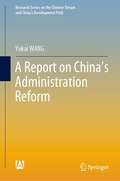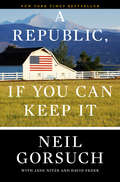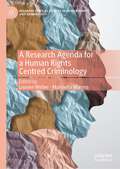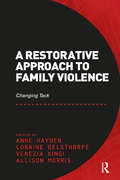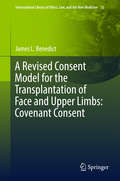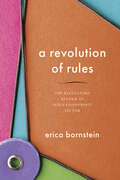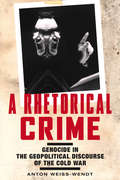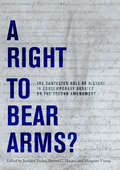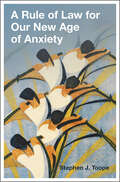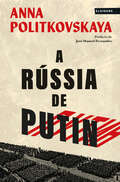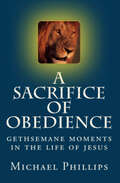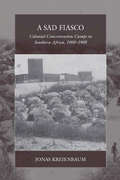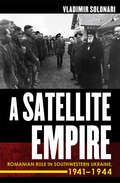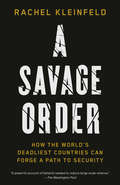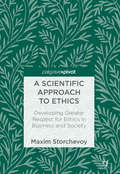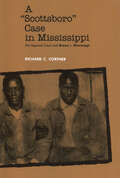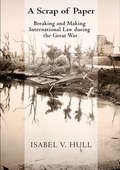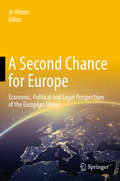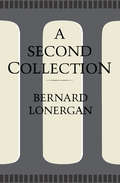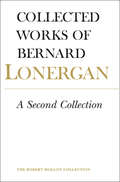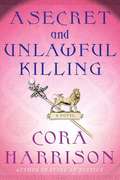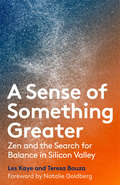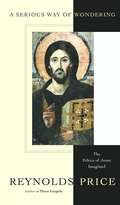- Table View
- List View
A Reluctant Spy: A gripping spy thriller debut
by David GoodmanRIGHT PLACE. RIGHT TIME. WRONG MAN.'Engrossing...ingenious...Goodman combines traditional elements - the nods to Buchan, Fleming and le Carré - with the topicality of 2020s technology and the threat from Russia' SUNDAY TIMES, THRILLERS OF THE MONTH'A gripping debut, perfect for fans of Mick Herron and David McCloskey' THE SUN'A twisty storyline and convincing action scenes make this a very promising debut' FINANCIAL TIMES'In the very top tier of espionage fiction' M. W. CRAVENJamie Tulloch is a successful exec at a top tech company, a long way from the tough upbringing that drove him to rise so far and so quickly. But he has a secret...since the age of 23, he's had a helping hand from the Legend Programme, a secret intelligence effort to prepare impenetrable backstories for undercover agents. Real people, living real lives, willing to hand over their identities for a few weeks in return for a helping hand with plum jobs, influence and access.When his tap on the shoulder finally comes, it's swiftly followed by the thud of a body. Arriving at a French airport ready to hand over his identity, Jamie finds his primary contact dead, the agent who's supposed to step into his life AWOL and his options for escape non-existent.Pitched into a deadly mission on hostile territory, Jamie must contend with a rogue Russian general, arms dealers, elite hackers, CIA tac-ops and the discovery of a brewing plan for war. Dangerously out of his depth, he must convince his sceptical mission handler he can do the job of a trained field agent while using his own life story as convincing cover.Can Jamie play himself well enough to avoid being killed - and to avert a lethal global conflict?'An excellent debut with terrific pace...will grip you to the end' JAMES SWALLOW'A twisting, edge-of-your-seat tale of mercenaries, greed, corruption, and espionage' I.S. BERRY'I was on the edge of my seat the whole time' ANTONY JOHNSTON'A rip-roaring page-turning keep-you-up-all-night thriller' NICHOLAS BINGE, author of ASCENSION'Smart, riveting, and eerily prescient' SUNYI DEAN, Sunday Times Bestselling author of THE BOOK EATERS'A pulse-pounding, twisting thrill-a-minute read that Slow Horses fans are going to absolutely love' ADAM SIMCOX
A Report on China’s Administration Reform (Research Series on the Chinese Dream and China’s Development Path)
by Yukai WANGThis book traces the history of China’s administrative reform in the past 35 years, focusing on the three phases of development, four guidelines and five major tasks of the reform since it is of great value to depict the entire process of China’s administrative system reform, analyzing the achievements, problems and prospects of the reform, and exploring experiences and lessons from the relationship between the administrative system reform and China’s economic, social and government transformation.
A Republic of Law
by Frank LovettThe rule of law is a valuable human achievement. It is valuable not only instrumentally, but also for its own sake as a significant aspect of social justice. Only in a society that enjoys the rule of law is it possible for people to regard one another as fellow free citizens; no one the master of anyone else. Nevertheless, the rule of law is poorly understood. In this book, Frank Lovett develops a rigorous conception of the rule of law that is grounded in legal positivism, and offers a civic republican argument for its value in terms of freedom from domination. Bridging persistent methodological gaps that divide legal philosophy, social science, and political theory, Lovett demonstrates how insights from all three can be united in a single powerful theory. This book will appeal to anyone interested in the rule of law, including scholars, legal officials, and policy-makers.
A Republic, If You Can Keep It
by Neil GorsuchJustice Neil Gorsuch reflects on his journey to the Supreme Court, the role of the judge under our Constitution, and the vital responsibility of each American to keep our republic strong. <P><P>As Benjamin Franklin left the Constitutional Convention, he was reportedly asked what kind of government the founders would propose. He replied, “A republic, if you can keep it.” <P><P>In this book, Justice Neil Gorsuch shares personal reflections, speeches, and essays that focus on the remarkable gift the framers left us in the Constitution. Justice Gorsuch draws on his thirty-year career as a lawyer, teacher, judge, and justice to explore essential aspects our Constitution, its separation of powers, and the liberties it is designed to protect. <P><P>He discusses the role of the judge in our constitutional order, and why he believes that originalism and textualism are the surest guides to interpreting our nation’s founding documents and protecting our freedoms. He explains, too, the importance of affordable access to the courts in realizing the promise of equal justice under law—while highlighting some of the challenges we face on this front today. <P><P>Along the way, Justice Gorsuch reveals some of the events that have shaped his life and outlook, from his upbringing in Colorado to his Supreme Court confirmation process. And he emphasizes the pivotal roles of civic education, civil discourse, and mutual respect in maintaining a healthy republic. <P><P>A Republic, If You Can Keep It offers compelling insights into Justice Gorsuch’s faith in America and its founding documents, his thoughts on our Constitution’s design and the judge’s place within it, and his beliefs about the responsibility each of us shares to sustain our distinctive republic of, by, and for “We the People.” <P><P><b>A New York Times Bestseller</b>
A Research Agenda for a Human Rights Centred Criminology (Palgrave Critical Studies in Human Rights and Criminology)
by Leanne Weber Marinella MarmoThis edited collection articulates a future direction for research at the nexus of criminology and human rights by bringing together experts from different branches of criminology and criminal justice who, while they may be sceptical about certain aspects of human rights theory or practice, share an interest in realising many of the objectives set out in human rights instruments. It argues that critical criminological research has a significant role to play in identifying whether state and state-corporate power is exercised in ways that align with human rights law and principles, although the discipline has been slow to advance this agenda. This book covers a wide array of topics and seeks to develop critical human rights approaches within criminology and criminal justice.Chapter 1 is available open access under a Creative Commons Attribution 4.0 International License via link.springer.com
A Restorative Approach to Family Violence: Changing Tack
by Loraine Gelsthorpe Allison Morris Anne HaydenThis volume provides an essential update on current thinking, practice and research into the use of restorative justice in the area of family violence. It contains contemporary empirical, theoretical and practical perspectives on the use of restorative justice for intimate partner and family violence, including sexual violence and elder abuse. Whilst raising issues relating to the implications of reporting, it provides a fresh look at victims’ issues as well as providing accounts of those who have participated in restorative justice processes and who have been victims of abusive relationships. Contributions are included from a wide range of perspectives to provide a balanced approach that is not simply polemic or advocating. Rather, the book genuinely raises the issue for debate, with the advantage of bringing into the open new research which has not been widely published previously. Given its unique experience in the development of restorative justice, the book includes empirical studies relating to New Zealand, contextualized within the global situation by the inclusion of perspectives on practices in the UK, Australia and North America. This book will be key reading for people who work with violent offending of a family nature as well as for those who are interested in the study of family violence.
A Revised Consent Model for the Transplantation of Face and Upper Limbs: Covenant Consent (International Library of Ethics, Law, and the New Medicine #73)
by James L. BenedictThis book supports the emerging field of vascularized composite allotransplantation (VCA) for face and upper-limb transplants by providing a revised, ethically appropriate consent model which takes into account what is actually required of facial and upper extremity transplant recipients. In place of consent as permission-giving, waiver, or autonomous authorization (the standard approaches), this book imagines consent as an ongoing mutual commitment, i. e. as covenant consent. The covenant consent model highlights the need for a durable personal relationship between the patient/subject and the care provider/researcher. Such a relationship is crucial given the recovery period of 5 years or more for VCA recipients. The case for covenant consent is made by first examining the field of vascularized composite allotransplantation, the history and present understandings of consent in health care, and the history and use of the covenant concept from its origins through its applications to health care ethics today. This book explains how standard approaches to consent are inadequate in light of the particular features of facial and upper limb transplantation. In contrast, use of the covenant concept creates a consent model that is more appropriate ethically for these very complex surgeries and long-term recoveries.
A Revolution of Rules: The Regulatory Reform of India’s Nonprofit Sector
by Erica BornsteinWhat is it about nonprofits that inspires so many to passionately support their agendas and others to adamantly seek their control? In India, laws regulating the nonprofit sector were dramatically reformed between 2010–2020, reconfiguring relationships between corporations, nonprofits, and the government. Thousands of nonprofits, including powerful NGOs, lost their ability to receive foreign funding, and in 2015 dozens more were put on a state-sponsored watch list. While many assume that nonprofits are defined by the causes they champion, A Revolution of Rules demonstrates that the nonprofit form is shaped primarily through its regulation, in a dynamic process of democratic and political negotiation. Erica Bornstein argues that the scrutiny of nonprofits in India must be understood in a wider, global context of political judicialization and regulatory reform. She examines how members of nonprofit organizations are the unsung heroes of democracy as they navigate a shrinking stage for rights-based work and struggle to protect civil society. The protagonists featured in this book include nonprofit workers, lawyers, accountants, philanthropists, and civil servants who conduct their work on the sidelines—at workshops, in modest offices, through report-writing and petitions. To understand nonprofits and their relationship to democracy in the world, Bornstein asserts, one must look to the deceptively unassuming sites of struggle over the nonprofit form and its regulation.
A Rhetorical Crime: Genocide in the Geopolitical Discourse of the Cold War (Genocide, Political Violence, Human Rights)
by Anton Weiss-Wendt Douglas Irvin-EricksonThe Genocide Convention was drafted by the United Nations in the late 1940s, as a response to the horrors of the Second World War. But was the Genocide Convention truly effective at achieving its humanitarian aims, or did it merely exacerbate the divisive rhetoric of Cold War geopolitics?A Rhetorical Crime shows how genocide morphed from a legal concept into a political discourse used in propaganda battles between the United States and the Soviet Union. Over the course of the Cold War era, nearly eighty countries were accused of genocide, and yet there were few real-time interventions to stop the atrocities committed by genocidal regimes like the Cambodian Khmer Rouge. Renowned genocide scholar Anton Weiss-Wendt employs a unique comparative approach, analyzing the statements of Soviet and American politicians, historians, and legal scholars in order to deduce why their moral posturing far exceeded their humanitarian action.
A Right to Bear Arms?: The Contested Role of History in Contemporary Debates on the Second Amendment
by Barton C. Hacker Jennifer Tucker Margaret ViningThis collection of essays explores the way history itself has become a contested element within the national legal debate about firearms. The debate over the Second Amendment has unveiled new and useful information about the history of guns and their possession and meaning in the United States of America. History itself has become contested ground in the debate about firearms and in the interpretation of the Second Amendment to the Constitution of the United States. Specifically this collection of essays gives special attention to the important and often overlooked dimension of the applications of history in the law. These essays illustrate the complexity of the firearms debate, the relation between law and behavior, and the role that historical knowledge plays in contemporary debates over law and policy. Wide-ranging and stimulating The Right to Bear Arms is bound to captivate both historians and casual readers alike.
A Rule of Law for Our New Age of Anxiety
by Stephen J ToopeTaking Auden's Age of Anxiety as a leitmotiv and drawing on literature from law, philosophy, political theory, international relations, and sociology, Toope argues with passion that a renewed faith in the rule of law can address troubling developments in our own anxious times: populist nationalism; globalisation; and disruptive technologies with their dominating platforms. We can address anxiety by bolstering social resilience, drawing upon a plural intellectual heritage. That heritage reveals a unique type of 'authority' in society, 'epistemic practical authority' built up continuously through social discourse and action, shifting focus from the state of 'being' to the dynamic of 'becoming.' What is law's role in this world? The modest, yet powerful, version of the rule of law advocated here is one that draws on a wellspring of practical wisdom - prudence gleaned from pragmatic experience. It chastens power, while not disconnecting law from other sources of social action and human agency.
A Rússia de Putin
by Anna PolitkóvskayaObra de leitura essencial para compreender o regime de Putin, a Guerra na Ucrânia e a Rússia de hoje. Anna Politkovskaya, conhecida por muitos como a «consciência moral perdida da Rússia», foi uma voz incómoda do regime de Putin e um arauto dos tempos sombrios que hoje vivemos, e que ela tão bem anteviu, com audácia e mestria, nas páginas bem documentadas e dramáticas que compõem este livro. Bestseller internacional. Prefácio à edição portuguesa de José Manuel Fernandes Elza Kungaeva, Natalia Gorbanevskaya, Pavel Fedulev ou Yaroslav Fadeev são alguns dos rostos de Moscovo, de São Petersburgo ou da Chechénia que protagonizam estas histórias da vida pública e privada da Rússia moderna e levantam o véu sobre o estado de coisas no longo inverno político de Vladimir Putin: a degeneração do Exército, o desaparecimento da intelligentsia, a estalinização do país, o crime organizado ou a corrupção endémica nas estruturas de poder. Anna Politkovskaya deu-lhes voz, reportando a verdade sobre Putin e o clima de medo instaurado na Nova Rússia, num espírito inquebrável de luta pela liberdade e na esperança de acordar uma sociedade que só quer ser embalada até adormecer. Obra de leitura essencial para compreender o regime de Putin, a Guerra na Ucrânia e a Rússia de hoje, A Rússia de Putin é o último livro publicado em vida por esta autora, uma das figuras mais célebres e premiadas do jornalismo internacional, ativista dos direitos humanos, cujo assassinato à porta de casa, em 2006, chocou o mundo. «Anna Politkovskaya recusou-se a mentir; o seu assassinato foi um ataque perpetrado contra a literatura mundial.» Nadine Gordimer «Continuaremos a lê-la e a aprender com ela durante muitos anos.» Salman Rushdie «Uma jornalista heroica.» The Guardian
A Sacrifice of Obedience: Gethsemane Moments in the Life of Jesus
by Michael PhillipsThe Christian author and George MacDonald biographer shares an enlightening meditation on the need for sacrifice in contemporary Christianity.Michael Phillips began writing A Sacrifice of Obedience in 2002, more than a decade before it was published. As the world moved further into the twenty-first century, the message of his book took on a more profound urgency. Christians everywhere—including Phillips himself—seem resistant the imperatives of sacrifice and obedience. Yet they remain the bull’s eye of the Christian faith. Now, after revisiting and expanding on his original manuscript, Phillips shares his candid and perceptive thoughts on the difficult yet deeply rewarding life all Christians are called to live.
A Sad Fiasco: Colonial Concentration Camps in Southern Africa, 1900–1908 (War and Genocide #29)
by Jonas KreienbaumOnly in recent years has the history of European colonial concentration camps in Africa—in which thousands of prisoners died in appalling conditions—become widely known beyond a handful of specialists. Although they preceded the Third Reich by many decades, the camps’ newfound notoriety has led many to ask to what extent they anticipated the horrors of the Holocaust. Were they designed for mass killing, a misbegotten attempt at modernization, or something else entirely? A Sad Fiasco confronts this difficult question head-on, reconstructing the actions of colonial officials in both British South Africa and German South-West Africa as well as the experiences of internees to explore both the similarities and the divergences between the African camps and their Nazi-era successors.
A Satellite Empire: Romanian Rule in Southwestern Ukraine, 1941–1944
by Vladimir SolonariSatellite Empire is an in-depth investigation of the political and social history of the area in southwestern Ukraine under Romanian occupation during World War II. Transnistria was the only occupied Soviet territory administered by a power other than Nazi Germany, a reward for Romanian participation in Operation Barbarossa.Vladimir Solonari's invaluable contribution to World War II history focuses on three main aspects of Romanian rule of Transnistria: with fascinating insights from recently opened archives, Solonari examines the conquest and delimitation of the region, the Romanian administration of the new territory, and how locals responded to the occupation. What did Romania want from the conquest? The first section of the book analyzes Romanian policy aims and its participation in the invasion of the USSR. Solonari then traces how Romanian administrators attempted, in contradictory and inconsistent ways, to make Transnistria "Romanian" and "civilized" while simultaneously using it as a dumping ground for 150,000 Jews and 20,000 Roma deported from a racially cleansed Romania. The author shows that the imperatives of total war eventually prioritized economic exploitation of the region over any other aims the Romanians may have had. In the final section, he uncovers local responses in terms of collaboration and resistance, in particular exploring relationships with the local Christian population, which initially welcomed the occupiers as liberators from Soviet oppression but eventually became hostile to them. Ever increasing hostility towards the occupying regime buoyed the numbers and efficacy of pro-Soviet resistance groups.
A Savage Order: How the World's Deadliest Countries Can Forge a Path to Security
by Rachel KleinfeldThe most violent places in the world today are not at war. More people have died in Mexico in recent years than in Iraq and Afghanistan combined. These parts of the world are instead buckling under a maelstrom of gangs, organized crime, political conflict, corruption, and state brutality. Such devastating violence can feel hopeless, yet some places—from Colombia to the Republic of Georgia—have been able to recover. In this powerfully argued and urgent book, Rachel Kleinfeld examines why some democracies, including our own, are crippled by extreme violence and how they can regain security. Drawing on fifteen years of study and firsthand field research—interviewing generals, former guerrillas, activists, politicians, mobsters, and law enforcement in countries around the world—Kleinfeld tells the stories of societies that successfully fought seemingly ingrained violence and offers penetrating conclusions about what must be done to build governments that are able to protect the lives of their citizens. Taking on existing literature and popular theories about war, crime, and foreign intervention, A Savage Order is a blistering yet inspiring investigation into what makes some countries peaceful and others war zones, and a blueprint for what we can do to help.
A Scientific Approach to Ethics: Developing Greater Respect for Ethics in Business and Society
by Maxim StorchevoyThis book suggests that normative ethics should be developed as a social science, and that this will improve its reputation in business and society. Storchevoy defines four criteria of a good scientific method (clear definitions, correct logic, empirical verification, accurate measurement) and demonstrates how normative ethics can make use of them. He provides a historical review of the methodological evolution of normative ethics and outlines how it was moving in a nonlinear way towards this scientific development by the 16th century. A Scientific Approach to Ethics challenges the reputation of ethics among many within business and business schools as unscientific and argues that it can come to be seen as a scientific discipline able to reveal universal moral truth.
A Scottsboro Case in Mississippi: The Supreme Court and Brown v. Mississippi
by Richard C. CortnerThis absorbing book is a systematic analysis of the litigation in Brown v. Mississippi, in which the Supreme Court made a pathbreaking decision in 1936 showing the unconstitutionality of coerced confessions. The case exonerated Ed Brown, Henry Shields, and Arthur (Yank) Ellington, three Black sharecroppers who had confessed under torture to the murder of a white planter. This case, similar to the notorious “Scottsboro” case in Alabama, paved the way for the controversial MIRANDA decision thirty years later. This book presents a dramatic story of both tragedy and triumph, one in which human nature is revealed at its best and at its worst, with courage, decency, and self-sacrifice contrasting sharply with bigotry, brutality, and indifference. Ultimately, however, A “Scottsboro” Case in Mississippi is an account of how the Supreme Court came to make a precedent-setting decision enhancing the protection of liberty under the Constitution.
A Scrap of Paper
by Isabel V. HullA century after the outbreak of the Great War, we have forgotten the central role that international law and the dramatically different interpretations of it played in the conflict's origins and conduct. In A Scrap of Paper, Isabel V. Hull compares wartime decision making in Germany, Great Britain, and France, weighing the impact of legal considerations in each. Throughout, she emphasizes the profound tension between international law and military necessity in time of war, and demonstrates how differences in state structures and legal traditions shaped the way in which each of the three belligerents fought the war Hull focuses on seven cases in which each government's response was shaped by its understanding of and respect for the law: Belgian neutrality, the land war in the west, the occupation of enemy territory, the blockade, unrestricted submarine warfare, the introduction of new weaponry (including poison gas and the zeppelin), and reprisals. Drawing on voluminous research in German, British, and French archives, the author reconstructs the debates over military decision making and clarifies the role played by law--where it constrained action, where it was manipulated to serve military need, where it was simply ignored, and how it developed in the crucible of combat. She concludes that Germany did not speak the same legal language as the two liberal democracies, with disastrous and far-reaching consequences. The first book on international law and the Great War published since 1920, A Scrap of Paper is a passionate defense of the role that the law must play to govern interstate relations in both peace and war.
A Second Chance for Europe: Economic, Political and Legal Perspectives of the European Union
by Jo RitzenThis book calls upon us to rethink and reboot the European Union. The authors dissect the EU's many vulnerabilities: how some Member States are backsliding on the rule of law, freedom of the press, and control of corruption - and how globalization's 'discontents' are threatening the liberal international order. It examines the need for a common immigration policy; the need to rethink the unsustainable debt overhang of some Eurozone countries; and the need to use education to foster a European identity. Given the sum total of these vulnerabilities, the book argues, the EU may not survive beyond 2025 in its present form - that is, unless decisive action is taken. In turn, the book puts forward a number of workable solutions: a European economic model to secure full employment; a stronger European Court of Human Rights to counter systemic violations; a points-based immigration policy; clear exit options for the Eurozone; and an Open Education Area with a common second language. These solutions may reduce the number of EU countries, but would increase cohesion and overall survivability.
A Second Collection
by Bernard Lonergan William F.J. Ryan Bernard J. TyrrellThis collection of essays, addresses, and one interview come from the years 1966-73, a period during most of which Bernard Lonergan was at work completing his Method in Theology. The eighteen chapters cover a wide spectrum of interest, dealing with such general topics as 'The Absence of God in Modern Culture' and 'The Future of Christianity,' narrowing down through items such as 'Belief: Today's Issue' and more specialized theological and philosophical studies, to one on his own community in the church ('The Response of the Jesuit ...') and the illuminating comment on his great work Insight ('Insight Revisited').This book is a reprint of the first edition published in 1974, edited by William F.J. Ryan and Bernard J. Tyrrell of Gonzaga University, Spokane. The editors contribute an important introduction in which they emphasize that Lonergan's central concern is intentionality analysis, and that two major themes run through the papers: first, the clear emergence of the primacy of the fourth level of human consciousness, the existential level, the level of evaluation and love; secondly, the significance of historical consciousness. These papers, then, besides the unity they possess by appearing within the same seven year period, share a specific unity of theme.Bernard Lonergan (1904-1984), a professor of theology, taught at Regis College, Harvard University, and Boston College. An established author known for his Insight and Method in Theology, Lonergan received numerous honorary doctorates, was a Companion of the Order of Canada in 1971 and was named as an original members of the International Theological Commission by Pope Paul VI.
A Second Collection
by Robert M. Doran SJ John Dadosky Bernard LonerganFor the edition of A Second Collection prepared for the Collected Works of Bernard Lonergan, editors Robert M. Doran and John D. Dadosky have added archival materials directly related to almost every one of the papers, bringing the reader closer to the original compositions. The papers date from 1966 to 1973, and span the most creative period in Lonergan's development. Two major themes run through these papers: the primacy of the fourth, existential level of human consciousness, and the significance of historical mindedness with all its implications for culture, hermeneutics, and phenomenological thinking. The theme of conversion makes a grand entrance in 'Theology in Its New Context,' a paper that charted the course for the unfolding of Method in Theology. This new edition makes extensive use of original manuscripts, variants in drafts of the essays, and hand-written corrections.
A Secret and Unlawful Killing: A Mystery of Medieval Ireland (Burren Mysteries #2)
by Cora HarrisonIt is 1509 and, for the people of the Burren in western Ireland, the Michaelmas Fair is a joyous time for trade and celebration, signaling the start of autumn. It's a chance to gather, buy and sell their wares, and pay tribute to the lord of their clans. But this year is different. The steward of the MacNamara clan has decided to raise the amount demanded for its tribute, and it's not long before tempers are running high. When the steward's body is found in the local churchyard, it falls upon Mara, the Burren's Brehon Judge, to piece the puzzle together. Was it revenge, greed, or something more sinister that motivated the murder? When another body is discovered, it is up to Mara--despite the distraction of a surprising marriage proposal--to bring the killer to justice before there can be yet another death.
A Sense of Something Greater: Zen and the Search for Balance in Silicon Valley
by Natalie Goldberg Les Kaye Teresa BouzaWelcome to Silicon Valley’s search for fulfillment and purpose beyond devices, money, and power. With worker stress at an all-time high, particularly in the fast-paced technology industry, it’s no surprise that Google, Salesforce, and Apple have adopted mindfulness and meditation into their workplace culture. Studies show mindfulness practice increases emotional intelligence, reduces stress, and enhances health and overall well-being. A Sense of Something Greater goes deeper than the current mindfulness trend, into the heart of Zen practice. For Les Kaye, Zen is more than awareness––it’s also “the continued determination to be authentic in relationships, to create meaningful, intimate, intentional bonds with people, things, and the environment.” Kaye’s teachings are paired with interviews with current tech employees and Zen practitioners, conducted by journalist Teresa Bouza. A Sense of Something Greater is an essential book for business leaders, mindfulness meditators, and Zen practitioners alike.
A Serious Way of Wondering
by Reynolds PriceWhen renowned novelist and poet Reynolds Price, one of Christianity's most eloquent outlaws, was invited to deliver the annual Peabody Lecture at Harvard University Memorial Church in 2001, he chose to explore a subject of fierce debate and timeless relevance: the ethics of Jesus. In two succeeding lectures at the National Cathedral and at Auburn Seminary, Price continued to explore the apparently contradictory ethics that Jesus articulates in the Gospels; and in a controversial act of artistic license, Price reimagined the historical Jesus. InA Serious Way of Wondering, Price expands these lectures to present Jesus with three problems of burning moral concern -- suicide, homosexuality, and the plight of women in male-dominated cultures and faiths. A sweeping view of the inescapable implications of Jesus' merciful life and all-embracing thought -- and of the benefits of enlarging our notions of humanity, community, and equality --A Serious Way of Wonderingis a significant contribution to Price's penetrating works of religious inquiry.

